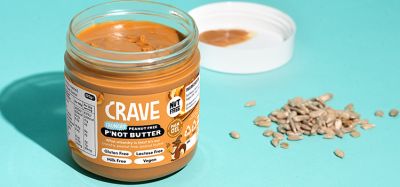Recent applied research in baking at Campden BRI
- Like
- Digg
- Del
- Tumblr
- VKontakte
- Buffer
- Love This
- Odnoklassniki
- Meneame
- Blogger
- Amazon
- Yahoo Mail
- Gmail
- AOL
- Newsvine
- HackerNews
- Evernote
- MySpace
- Mail.ru
- Viadeo
- Line
- Comments
- Yummly
- SMS
- Viber
- Telegram
- Subscribe
- Skype
- Facebook Messenger
- Kakao
- LiveJournal
- Yammer
- Edgar
- Fintel
- Mix
- Instapaper
- Copy Link
Posted: 12 December 2009 | Gary Tucker, Head of Bakery & Cereal Processing Department, Campden BRI | No comments yet
At Campden BRI, the Department of Baking & Cereal Processing aims to combine science and technology in order to provide technical support for the international baking and cereal processing industries. The success of the Department is based on a broad, practical experience of cereal and bakery technologies that enables it to help customers resolve ingredient and processing problems, and to measure ingredient and product quality.
Training programmes offered by the team are renowned for their practical elements combined with sound technical knowledge, and are equally popular with global businesses and artisan bakers. In addition to the courses listed in the training brochure, there are at least as many confidential courses given to clients, held either at Campden BRI or a client’s site. These enable the course content to focus on ingredients, products and processes that are specific to a single client, and discussions are confidential to that client. This type of course has been gaining in popularity for some time.
This article, however, will focus on two key areas for developing research and services, which are currently the contribution of baked products to a healthier diet and sustainable manufacturing. Highlights from recent projects are presented.
Making bread at high ambient temperatures
Bread making operations are known to be affected by the temperature in the bakery during dough mixing and development. For example, bakers report that high ambient temperatures can result in uncontrolled fermentation, yielding sticky un-processable dough and dough collapse during proving or baking. This member subscription funded project assesses the precise impact of high ambient temperatures at various stages of bread production on the practicalities of the process and the quality of dough and bread produced.
Whilst high dough temperature during mixing or high ambient bakery temperatures can be shown to result in sticky dough, causing handling problems during moulding, the high bakery temperatures were not found to affect bread volume or crumb quality as such. However, if not addressed, the problem of dough stickiness will significantly compromise production output.
In addition to quantifiable effects on dough properties, changes in flour properties were also observed (see Figure 1). Peak viscosity in flour-water pastes increased, while dough rheology became ‘tighter’. The latter is probably due to increased intermolecular protein-to-protein bonding. Interestingly, use of flours stored at high temperatures resulted in less sticky doughs with good crumb structure – offering a possible route to reduced dough stickiness during processing.
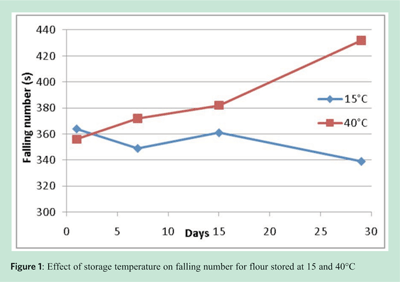

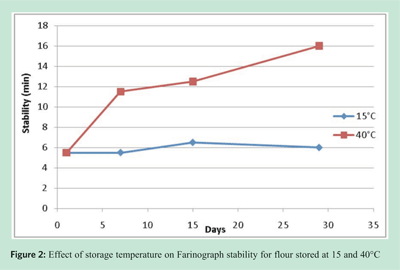

Campden BRI has recently modified the test bakery to provide increased flexibility and control of bakery temperature and humidity. This project has been undertaken in recognition that bakeries in hot climates, and also in the UK and other temperate climates in the summer, experience rises in temperature and humidity which can impact on dough handling and bread quality. Test bakes can now be carried out over an ambient temperature range of 20 to 40°C with relative humidity ranging from 30 to 80 per cent. This will enable work to determine the effect of environmental factors on dough development and bread quality. This facility is available to companies wishing to carry out studies on the impact of the environment on their bakery products and processes.
Starch as an ingredient
Starch is an important ingredient in a range of formulated products, many of which are baked. The department has considerable experience and offers various resources to support members in the use of starches, including clean label forms. For example, the starch handbook ‘Cereal and tuber starches: their nature and performance in foods’ (Campden BRI Review 51) provides considerable background information on the technology and uses of starches, whilst two R&D Reports (Nos. 242 and 252) detail investigations into clean label starches. Meanwhile, New Technologies Bulletin No. 35 includes a review of clean label ingredients, including clean label starches.
Egg protein functionality
Egg is a highly functional ingredient which is used in many food products. The coagulation of egg proteins is important in many bakery products such as cakes, meringues, soufflés and pie fillings. The coagulation binds the protein molecules together and sets the final structure. Despite its importance, there is no established method to characterise the functional properties of egg or determine batch-to-batch variations in functionality. The objective of work on egg was to gain better knowledge about raw material and ingredient properties and interactions in the processing of foam-based foods.
Instrument-based methods were established to help predict the contribution and suitability for the use of egg materials in baked goods such as cakes, quiches, pasta and noodles, Yorkshire pudding and biscuits. One method in particular – rapid visco analysis (RVA) – also has the potential to provide a rapid QC test for liquid egg. The work with RVA has generated methods to measure viscosity changes in egg batches. These can be used to help understand why some batches do not perform well, even when established quality checks such as a foaming test, refractive index and pH measurements show the materials to be within specification.
In parallel, rheological studies using oscillatory rheological testing have identified approaches for assessing the final firmness of the cooked gels, and for studying the relative contributions of egg and yolk. The practical benefits to ingredients suppliers and users from this member-funded work are being explored further through an industry club project focused on applying RVA to selected egg uses and products.
Reduced salt bread
Another key issue for the nation’s diet and health is reducing the salt content of manufactured foods. While bread itself is not excessive in its salt content, it forms a considerable part of the diet for most people. It is therefore a target food for the FSA. Campden BRI were part of a project sponsored by the FSA to understand how salt affects dough properties, with the objective of improving fundamental knowledge and through this, finding new ways to achieve the lower salt levels for bread set out in the Agency’s salt target for bread to be achieved by 2010.
The issue is that large scale plant bakers experience difficulties in reducing the salt content of premium bread due to changes in the handling properties of dough at reduced salt contents which results in higher levels of bakery waste. The project approach focused on how the level of salt addition affected the dynamics of water and salt distribution in the mixed dough. Test baking confirmed that machine moulding of bread dough became more difficult at lower salt contents when dough temperature was elevated, or when the delay time between mixing and moulding was increased. The most extreme evidence of this was dough ‘sticking up’ in the test bakery moulder. This trend was consistent with industrial experience where reduced salt doughs result in plant stoppages due to sticky doughs fouling the moulders (see Figure 3). Under certain circumstances, salt reduction led to a reduction in the specific volume of the baked loaf and this is possibly related to a reduction in the starch gelatinisation temperature as salt level is decreased. The problems of collapse and open texture were not found to be related to salt level under the conditions of test baking.
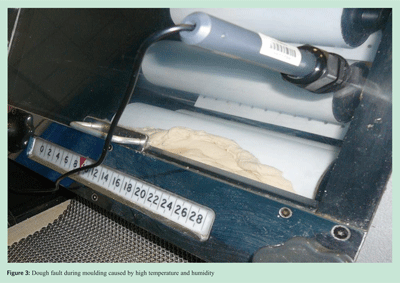

This research is leading towards a new proposal involving several UK research groups and companies, in which solutions to the problems of handling sticky doughs will be addressed. The proposal will be put forward for funding under a collaborative scheme such as LINK.
It is widely recognised that the dough stickiness methods used both by industry and research groups are inadequate to distinguish between sticky and non-sticky dough in terms of machine-ability. The research partners in the FSA sponsored project have used standard methods reported in the literature and modifications of these tests, all with limited success. This finding is in agreement with the experience of plant bakers who also report limited success with their in-house methods. Work at Campden BRI has shown that stickiness tests used in other industries, such as the peel test used in the adhesives industry, have limited application to dough. However, there has been an increase in our understanding of the reasons behind the limitations of current methodologies and Campden BRI is progressing a new approach to the measurement of the stickiness problem with its members to provide the industry with a tool to monitor dough handling quality.
Application of new enzymes to improve raw material functionality in foods
Processed food products can rely heavily on functional materials to produce some benefit in processing, end product quality, or to influence the shelf life of the product. A number of enzymes are widely used in the food industry and their activity and functionality are well understood. However, when new enzymes become available, little is known about their main activity, side activities or functionality in different products and processes. For example, it would not be possible to deduce from a research paper whether a particular enzyme has beneficial effects across all bread products or how they should be used most effectively. A number of new enzymes have become commercially available that claim to possess specific activities that can potentially give improvements in terms of processing and produce healthier products. A better knowledge of the action of such enzymes would help to better target the use of these new ingredients in commercial products and processes as well as offering potential for improving ingredient functionality, end-product quality and nutritional composition.
Research at Campden BRI has demonstrated that the application of commercially available endo-xylanases significantly increased the soluble fibre content of white bread. Increased levels of soluble fibre suggested that the nutritional quality of white bread can be improved. This would be a considerable benefit to the diet of consumers, particularly children who tend to favour white bread over wholemeal, and thus promote better health. The knowledge developed in this project could be used by bakers to produce nutritionally improved white bread products.
Another research area is to address the considerable consumer pressure on manufacturers to use clean label ingredients. One possible route to achieve this is by the application of enzymes to produce functional materials from natural ingredients. Lipases are very important enzymes in that they are able to modify lipid materials naturally present in flour and bakery shortenings and generate products that are more functional than the original substrates (see Figure 4). The new materials generated by the enzyme are known to possess surface active properties and function as foaming agents and emulsifiers and to aid dough processing as well as benefiting product texture and keeping quality. Research found that the addition of a lipase to produce white bread did not achieve the loaf volume of bread made with DATEM esters, but matched the crumb softening performance of the emulsifier, whereas in the wholemeal bread, lipase functionality was similar to that of the DATEM esters. The results indicate that depending on the flour type, the lipase studied can partially or fully replace the addition of DATEM esters by making use of lipid materials naturally present in flour. Lipase use therefore offers the industry a route to reformulate and remove E-number(s) from the product label.
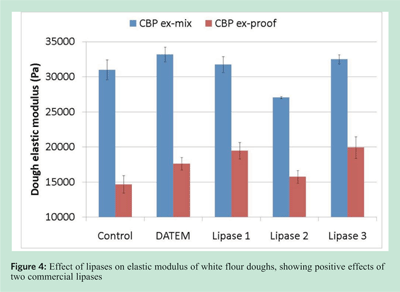

Clostridium botulinum growth in baked goods
Clostridium botulinum is not usually a microorganism of concern with baked foods. Although regarded as an anaerobic bacterium (grows in the absence of oxygen), there is some evidence that Clostridium botulinum can grow under conditions where oxygen is present. Baked products appear on the market in aerobic and anaerobic (Modified Atmosphere Packaged) formats. In a new Club-funded project, the ability of proteolytic C. botulinum to grow and produce toxin in UK-produced baked goods (e.g. white and wholemeal bread, naan bread and muffins) under aerobic and anaerobic conditions will be investigated. This is a new initiative in which manufacturers and retailers of bakery products (and other interested companies) are invited to participate in this Club.






